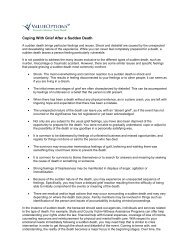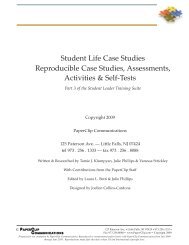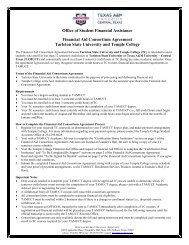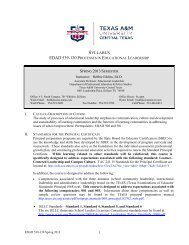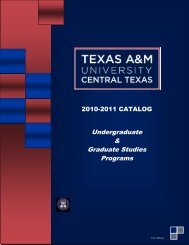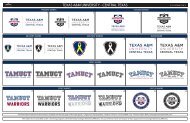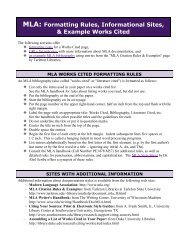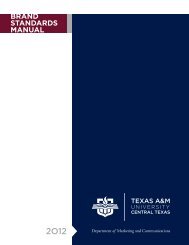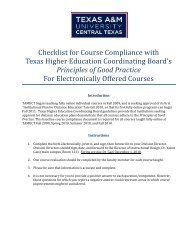Texas Budget Response - Texas A&M University-Central Texas
Texas Budget Response - Texas A&M University-Central Texas
Texas Budget Response - Texas A&M University-Central Texas
You also want an ePaper? Increase the reach of your titles
YUMPU automatically turns print PDFs into web optimized ePapers that Google loves.
ADMINISTRATOR'S STATEMENT<br />
82nd Regular Session, Agency Submission, Version 1<br />
Automated <strong>Budget</strong> and Evaluation System of <strong>Texas</strong> (ABEST)<br />
DATE:<br />
TIME:<br />
PAGE:<br />
8/9/2010<br />
9:05:02AM<br />
3 of 6<br />
Agency code: 770<br />
Agency name:<br />
<strong>Texas</strong> A&M <strong>University</strong> - <strong>Central</strong> <strong>Texas</strong><br />
ARRA Funding<br />
During the 2010-2011 biennium, $80 million in ARRA funding was used by the State of <strong>Texas</strong> to fund the performance incentive program. TAMUCT used these funds to retain<br />
3.5 full-time equivalent positions in the student services area, to fund technology upgrades and licenses for the general purpose student computer lab, to purchase software needed<br />
for course assignments, and to maintain its four-year computer and printer rotation program to assure that students have the most current technology the university can provide. A<br />
withdrawal of those funds may force the university to a five-year rotation for the replacement of instructional computer equipment, and will inevitably delay software purchases.<br />
Both outcomes will impact student ability to complete assignments and will threaten the adequacy of their preparation on newer versions of hardware and software now in common<br />
use in the workplace.<br />
10% General Revenue-Related Base Reduction<br />
As a new and growing institution of higher learning, substantial budget reductions present a special challenge to TAMUCT. As TAMUCT administrative staff systematically<br />
reviewed options for potential reductions, a guiding principle was established, that the impact on instructional delivery and student support services and success initiatives would<br />
be minimized as much as possible. With that principle in mind, the following strategies were developed:<br />
1. Across the board reductions in the operating budgets of all departments. While this strategy will spread the impact across all levels of university operations, it may adversely<br />
impact departments and services that have remained underfunded during the transition of TAMUCT from TSU. The impact is magnified by enrollment growth which will present<br />
a challenge to maintaining current-level services. The reduction will notably decrease funds available for marketing and recruiting, potentially limiting the university’s ability to<br />
continue to attract new students and to grow its way out of current funding constraints.<br />
2. Additional reductions to facility operating budgets. This strategy will impact the use and maintenance of current facilities, all of which are leased, while simultaneously<br />
impacting the university’s ability to make lease payments. In addition, it may also adversely affect funding available for the installation of classroom technology not covered by<br />
TRB or PUF funding during the construction of the university’s first permanent building.<br />
3. Delayed capital purchases for FY 2012 and FY 2013. This strategy will force delays in the purchase of library holdings and technology for general purpose computer labs and<br />
classrooms, both essential for a developing institution.<br />
4. Reduced reliance on General Revenue for scholarships. The university will attempt to replace the reduction of funds by seeking increased external support to a least maintain<br />
the current level of scholarship assistance needed to attract and retain students, and to reward student success.<br />
Organization<br />
The organizational structure for TAMUCT reflects the institution’s emphasis on ensuring student success by steadily strengthening its capability to deliver high quality, rigorous<br />
instructional programs and effective student support services. To that end, it will maintain a relatively flat administrative structure, minimizing the emphasis on upper-level<br />
administration while focusing on the hiring of highly-qualified faculty and student support staff.<br />
The TAMUCT organizational structure is currently under review by its president to determine how to most effectively ensure administrative coverage without shifting limited<br />
resources from instruction or student support services.<br />
Background Checks<br />
Criminal background checks are conducted by TAMUCT under <strong>Texas</strong> Education Code Section 51.215 and <strong>Texas</strong> Government Chapter 411 Subchapter (f). All positions within<br />
the university are considered security-sensitive and require a background check. In full compliance with the TAMUS Policy 33.99.14, TAMUCT has developed a proposed<br />
university rule on criminal background checks that is currently being reviewed and evaluated by TAMUS Office of General Counsel.<br />
Page 3 of 81



